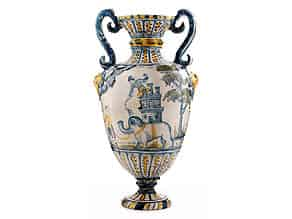Auction Maiolica
» reset
Your personal art agent

You would like to purchase a similar object?
We are happy to inform you, if similar works are to be auctioned in one of our upcoming auctions.
Please accept our privacy policy
575
Majolika-Apothekergefäß
Höhe: 62,5 cm.
Durchmesser: 31 cm.
Castelli, 17. Jahrhundert.
Catalogue price € 10.000 - 12.000
Catalogue price€ 10.000 - 12.000
$ 10,800 - 12,960
£ 9,000 - 10,800
元 78,200 - 93,840
₽ 994,900 - 1,193,880
Hohe Arznei-Vase auf Balusterfuß mit elegantem, S-förmig geschwungenem Doppelhenkel und engem, sich nach oben öffnendem Hals. Fuß und Hals sind mit einem geometrischen Streifenmuster dekoriert, der Hals zusätzlich mit Eierstabdekor. Auf der Schauseite ist König Mithridates in einer Landschaft dargestellt. Er trägt ein antikisches Gewand und eine Krone. In der einen Hand hält er ein Salbgefäß empor, die andere hält zwei längliche Pflanzenteile. Rückseitig ist ein Elefant zu sehen, der von einem größeren Mann geführt wird und einen burgartigen Sitzaufbau trägt. Auf diesem sitzt ein Reiter mit mehrschwänziger Geißel. Bemalung in Gelb, Orange, Blau und Grün auf weißem Fond. Fuß wieder angesetzt, Bruchrest.
Anmerkung:
Mithridaticum war eine Arzneimittelzubereitung, die der Behandlung von Vergiftungen diente. Es soll von König Mithridates VI. von Pontus im 1. Jahrhundert v. Chr. erfunden worden sein. Vgl. Rudolf E. A. Drey, "Apothekengefäße. Eine Geschichte der pharmazeutischen Keramik", München, 1980, S. 224, Glossar. (9300079)
Maiolica drug jar
Height: 62.5 cm.
Diameter: 31 cm.
Castelli, 17th century.
Tall drug jar on a baluster shaped foot, with a pair of elegant, S-shaped handles, a narrow neck and everted rim. Foot and neck are decorated with a geometrical striped pattern, the neck additionally painted with egg-and-dart band. The front depicts the mythological scene of King Mithridates in a landscape. He wears an antique garment and a crown and holds up an ointment vessel in one hand and two plants in the other. On the reverse, a man guides an elephant that is smaller than its guide; another man, seated in a chair in the form of a castle on the back of the elephant holds a multi-tail whip. Painted in yellow, orange, blue and green on a white ground. Foot broken and re-stuck; cracked and restored.
Notes:
Mithridaticum is a drug that was used to treat poisoning. According to legend, the drug was developed by King Mithridates VI of Pontus in the first century BC.
See Rudolf E. A. Drey, Apothekengefäße. Eine Geschichte der pharmazeutischen Keramik, Munich, 1980, p. 224, glossary.
This object has been individually compared to the information in the Art Loss Register data bank and is not registered there as stolen or missing.
Your personal art agent
You would like to be informed of upcoming auctions if a similar work of art is offered? Activate your personal art agent here.
Please accept our privacy policy
You would like to purchase a similar object?
Your personal art agent Purchase in Private Sale Calendar
Our experts are happy to support you personally in your search for art objects.
You would like to sell a similar artwork in auction?
Consign now Private Sale Service FAQ
Your consignments are always welcome.
Our staff will be happy to personally assist you every step of the way. We look forward to your call.
Get in touch with our experts
further catalogues Furniture | 16th - 18th Century Paintings | Porcelain, silver, rock crystal | Library | Sculpture and Works of Art | Ceramics | Maiolica | Hampel Living | 19th - 20th Century Paintings | Russian Art | Modern Art | Asian Art, Jewellery & Watches | Books, drawings and engravings | Folk Art and Miscellaneous
















